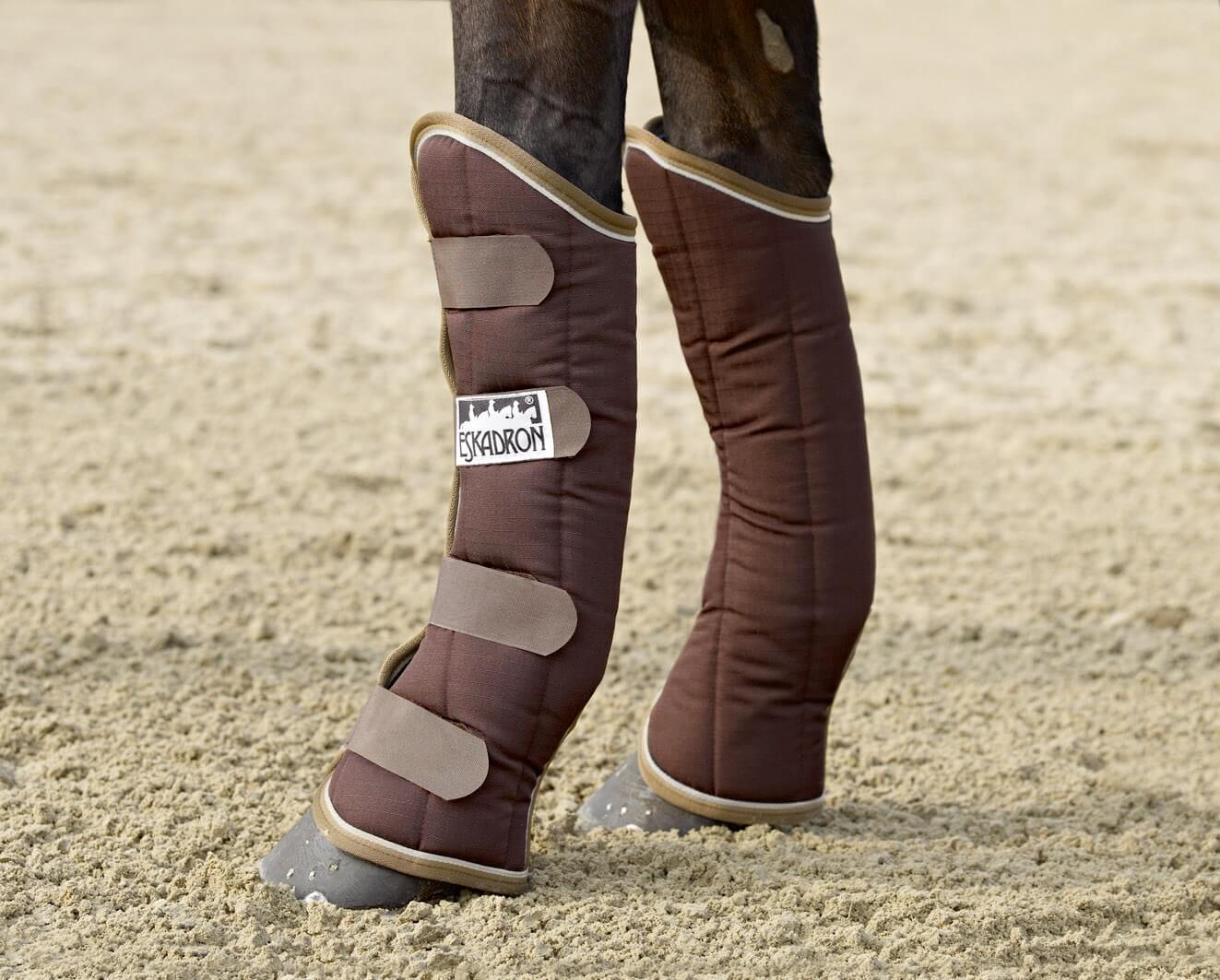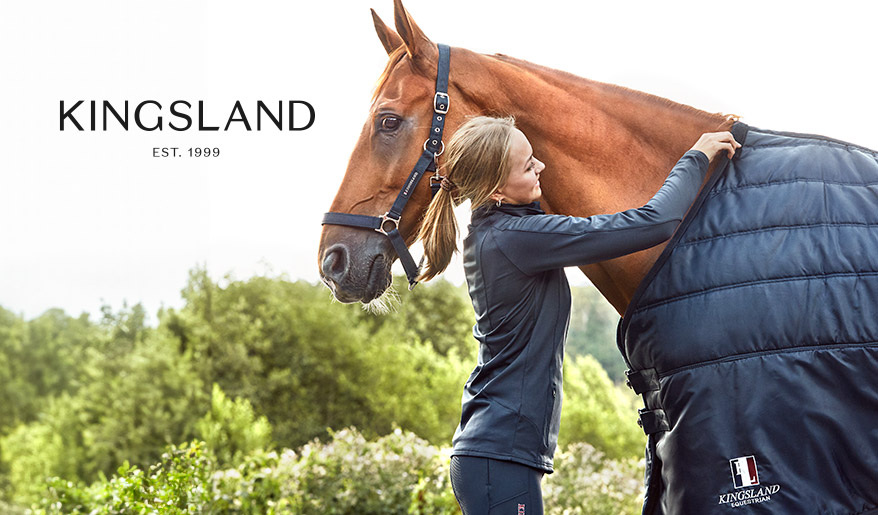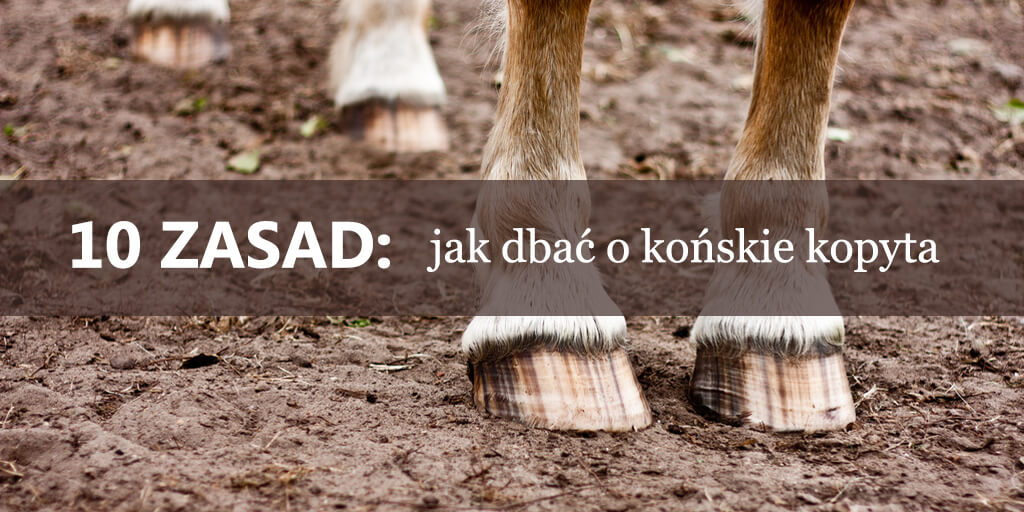
źródło tła:
PimthidaPostanowiliśmy zebrać dla Was 10 zasad: jak odpowiednio zadbać o końskie kopyta, by jak najdłużej utrzymać je w zdrowiu i dobrej kondycji. Wszyscy dobrze znamy powiedzenie, że "bez kopyt nie ma konia", stąd kopyta powinny stać się nr 1 na liście codziennej pielęgnacji :)
1. Regularnie czyść kopyta konia
Tak, wiemy, że to banał... ale zdziwilibyście się, jak wielu właścicieli zaniedbuje kopyta swoich koni już na tym etapie. Regularne czyszczenie kopyt jest podstawą ich pielęgnacji i najlepszą profilaktyką, zapobiegającą rozwijaniu się jakichkolwiek chorób i problemów z ich zdrowiem. Przed każdą jazdą sprawdź, czy w spodzie kopyta tj. strzałce, rowku bądź w piętce nie znajduje się jakiś kamień bądź inne małe obiekty (np. kawałki szkła). Jeśli jakiekolwiek przedmioty mogące uszkodzić kopyto pozostaną w nim na czas jazdy, a Wy dociążycie zwierzę swoim ciężarem, jadąc jeszcze po twardym gruncie, to niestety wbiją się one jeszcze głębiej. Może to spowodować skaleczenia, które przyczynią się do nawet dłuższej kontuzji.
Niewielu jeźdźców sprawdza też końskie kopyta po jeździe, czy też przed i po transporcie. To duży błąd! Sprawdzenie kopyt zajmie Wam niewiele czasu w stosunku do tego, jak straszne skutki może mieć Wasza pobłażliwość wobec zagrożeń, jakie niesie dla koni cywilizacja. Niestety ale konie w swoim naturalnym środowisku nie trafiały niegdyś na taką ilość śmieci i ostrych przedmiotów, jak mogą napotkać obecnie - kawałki potłuczonego szkła, puszek, butelek, gwoździ... Można by stworzyć całą listę takich cudów :) Co więcej, takie sprawdzanie kopyt da Wam również szansę na obejrzenie końskich nóg i całej puszki kopytowej, więc będziecie w stanie wychwycić wszelkie nieprawidłowości i ewentualne skaleczenia po jeździe czy po odbytej podróży.
Pamiętajcie, że dobrą opcją jest kopystka dla konia nie tylko z metalowym szpikulcem, ale także z przymocowaną sztywną szczotką, która pozwoli Wam łatwiej i dokładniej usunąć pozostałości różnych materii z trudno dostępnych miejsc.
2. Poznaj kopyta swojego konia
Podczas codziennego czyszczenia i oglądania kopyt swego konia ustal, co jest w nich charakterystyczne. Jeśli nauczysz się ich "na pamięć", będzie Ci łatwiej zauważyć wszelkie odchylenia i odstępstwa od normy.
Pamiętaj też, że co najmniej dwa razy w roku strzałka kopyta ulega złuszczeniu. Ten proces może umknąć Twojej uwadze, jeśli Twój kowal systematycznie rozczyszcza kopyta Twego konia. Jeśli jednak zauważysz odrywającą się uschniętą część strzałki, nie ma co podnosić rabanu ;) Wszystko jest w najlepszym porządku.
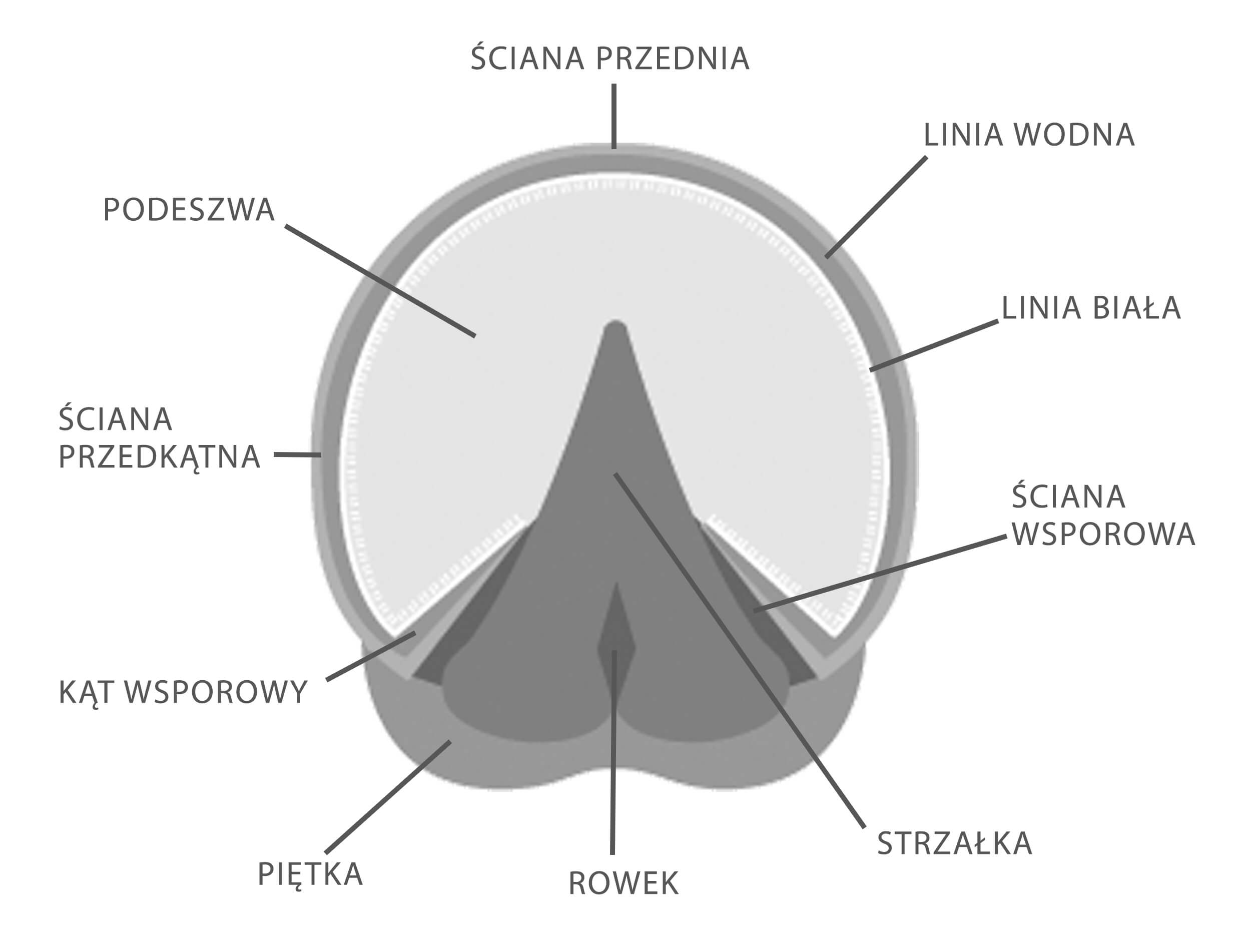
3. Podnosząc kopyto, zwracaj uwagę na...
na zapach i strukturę kopyta
Jeśli kopyto jest miękkie i nieprzyjemnie pachnie, to może oznaczać, że zaczęły się w nim procesy gnilne. Gnicie kopyta to stan bakteryjny zwykle spowodowany przez długotrwałe stanie konia w niewymienianej ściółce, błocie lub na innym mokrym i brudnym podłożu. Często przyczynia się do niego również długotrwałe podkuwanie konia z użyciem tzw. podkładek. Gnicie najłatwiej rozpoznać po już wspomnianym zapachu, często mazistej, mokrej i miękkiej strukturze kopyta - strzałki, rowka, a nawet i piętki. Wczesne stadium choroby nie jest trudne do wyleczenia. Jednak długotrwały proces może ostatecznie spowodować trwałe kalectwo oraz znaczne szkody w strukturze kopyt naszego konia.
Jeśli zauważacie efekty rozwóju bakterii w kopytach Waszego konia, postarajcie się przede wszystkim zafundować mu częstszy pobyt na pastwisku. Oczywiście nie wtedy, kiedy teren jest błotnisty, ale suchy bądź pokryty śniegiem czy zieloną trawą. Starajcie się trzymać go na suchej ściółce, najlepiej nie na słomie, a na czymś dużo bardziej chłonnym (przykładów innych ściółek szukajcie w naszym poprzednim artykule, który znajdziecie TUTAJ). Warto zastosować też preparaty i zabiegi mogące pomóc Wam w pozbyciu się problemu (więcej na ten temat przeczytacie TUTAJ).
Konie różnią się między sobą budową kopyta - te o "ciasnych" i "wąskich" kopytach, będą miały tendencję do tworzenia pewnego rodzaju "pułapki" na ciała obce (gwoździe, patyki, szkło) oraz brud (piasek, resztki obornika), który z łatwością będzie się w nich gromadził. Takim koniom powinno się więc poświęcać więcej uwagi, warto też w porozumieniu z kowalem dążyć do rozwiązania tych problemów, oczywiście w miarę możliwości.
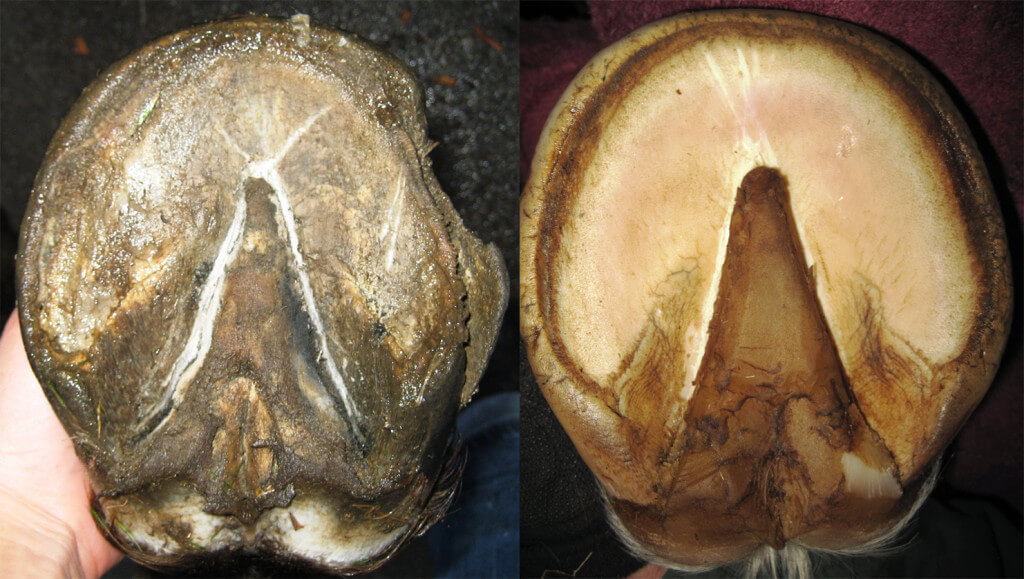
Po lewej: kopyto z postępującym procesem gnilnym. Po prawej: zdrowe rozczyszczone kopyto, źródło: heikebean.com
Jako przykład przytoczymy historię pewnych właścicieli:
Koń nie mógł stawać na przedniej nodze. Problem ewidentnie dotyczył kopyta. Puszka kopytowa miała podniesioną temperaturę, a podczas obmacywania kopyta koń wyrywał nogę, więc nacisk ewidentnie powodował u niego ból. Co więcej, w okolicy strzałki i podeszwy pojawiło się małe miękkie uwypuklenie, jakby zbierała się tam ropa. Przyjechał weterynarz, obejrzał chore miejsce, naciął kopyto, spuścił ropę i znalazł źródło problemu - małą drzazgę wbitą w rowek strzałki. Minęło kilka dni, kiedy koń przyjmował leki i stał w co rusz to nowych opatrunkach. Jednak zwierzę wciąż nie było w stanie stanąć na nodze, bo kopyto promieniowało z bólu. Nadal zbierała się tam ropa, jakby miejsce nie było w stanie się zagoić, jakby źródło problemu nie zostało usunięte. Wtedy postanowiono wezwać kowala, by spróbował znaleźć problem głębiej. Jak duże zdziwienie wywołał fakt, gdy kowal, rozczyszczając kopyto odkrył, że w rowek strzałki w poprzek kopyta, pod płaską część podeszwy, wbił się gruby 5-6 cm patyk z nieco naostrzonym końcem. Fizycznie wydawało się to aż nie możliwe, jak takiej wielkości "drzazga", mogła wbić się w strzałkę i dalej ponad centymetr pod powierzchnię podeszwy kopyta. Jak mogło to pozostać niezauważone podczas czyszczenia kopyt? Mogło, ponieważ, jeśli kopyto choruje i jego tkanka jest zbyt miękka, zwierzę jest bardziej wystawione na niebezpieczeństwo urazów.
W przegniłe kopyto patyk tej wielkości wszedł jak w masło, tak, że stał się niewidoczny, bo cały schował się w kopycie. Mogło się to wydarzyć nawet na pastwisku, poza kontrolą właściciela. Jednak to winą właściciela był brak kontroli stanu kopyt i to on nie zapobiegł postępującym procesom gnilnym, które tak naprawdę stały się przyczyną skaleczenia.
Takich historii można by przytoczyć wiele. Jednak byłoby dobrze dla Was i Waszych koni, by opowiadać je jako niedotyczące Was legendy ;) Nie bagatelizujmy więc takich nawet najbardziej banalnych objawów.
Jeśli gwóźdź lub inny obiekt przebija podeszwę konia, rana prawdopodobnie będzie niewidoczna. Jednak większość ciał obcych możemy zauważyć od razu. Jeśli nie macie do czynienia z maleńką drzazgą, która wbiła się na kilka milimetrów w kopyto, możecie wyjąć ją samodzielnie. Następnie odkazić miejsce skaleczenia, ewentualnie założyć opatrunek. Jednak gdy nie wiecie, ile czasu ciało obce znajduje się w kopycie, jak duże ono jest i jak głęboko się wbiło, nie wyjmujcie go samodzielnie! Owińcie kopyto konia, by przedmiot nie mógł się przesuwać i umieśćcie konia w boksie na czystej ściółce, czekając na przyjazd weterynarza. W ranę mogło wdać się zakażenie, więc niech to lekarz weterynarii usunie obiekt i zaleci kurację.
Niektóre pęknięcia są powierzchowne, inne mogą dotyczyć nawet wrażliwych struktur kopyta. Przyczyny mogą być różne - przykładowo: kopyto może być osłabione ze względu na ogólny średni stan zdrowia konia, więc przy mocniejszym stuknięciu doszło do uszkodzenia mechanicznego i stąd pęknięcie. Inną przyczyną pęknięć bywa ropień. Jeśli na kopytach swego konia zauważasz pęknięcia, szczególnie rozległe i głębokie, zadzwoń do kowala, opisując ich położenie i rozmiar (najlepiej przesyłając zdjęcie). Niech to specjalista zadecyduje, czy należy poświęcić temu szczególną uwagę już teraz, czy może to czekać aż do następnego regularnego rozczyszczania.
podwyższoną temperaturę i puls
Bardzo ciepłe kopyto zawsze oznacza, że dzieje się z nim coś niedobrego. Jeśli po sprawdzeniu pulsu za pomocą dwóch palców przyłożonych do tylnej części pęciny nad piętką w charakterystycznym wgłębieniu, stwierdzimy, że jest on bardzo mocno wyczuwalny i wyższy niż normalnie to również powinno nas to zaniepokoić (oczywiście wtedy, kiedy koń nie jest niedługo po wysiłku, ale stoi już od dłuższego czasu w boksie). Być może są to objawy jakichś uszkodzeń mechanicznych, w wyniku których w kopycie zbiera się ropa? Koń ma aż cztery kopyta, mamy więc zawsze szansę porównania ich do siebie i łatwiej będzie nam stwierdzić, czy rzeczywiście dzieje się coś, co powinno wzbudzić naszą czujność. Warto wezwać weterynarza, by wraz z nim poszukać przyczyny.
Jeśli takie objawy pojawiły się niedługo po kuciu konia, warto wezwać kowala ponownie. Być może przyczyną jest zagwożdżenie, spowodowane zbyt głębokim bądź złym wbiciem podkowiaka?
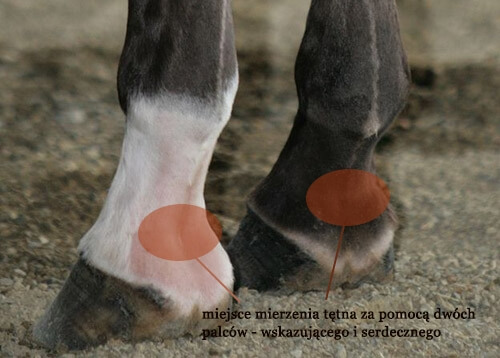
Miejsce mierzenia tętna - pęcina, źródło tła: theequinest.com
Jeśli wzrost temperatury i wyczuwalny silniej niż zwykle puls zauważymy na obu przednich kopytach, a dodatkowo koń będzie przestępował z nogi na nogę, miał trudności z poruszaniem się, będzie próbował się kłaść albo obejmie charakterystyczną pozycję z wysunięciem do przodu kończyn przednich czy pozycję "siedzącego psa" - to powinien być dla nas jasny sygnał, że chodzi o ochwat. Ochwat to stan zapalny, który może spowodować poważne uszkodzenia kopyt. Jeśli nie zareagujemy wystarczająco szybko, może okazać się nawet śmiertelny!
4. Ustal kalendarz regularnych wizyt kowala
Ogólnie przyjmuje się, że wizyta kowalska powinna odbywać się średnio co 6-8 tygodni, a więc co 1,5-2 miesiące. Jednak w praktyce te odstępy różnią się w zależności od potrzeb naszego konia oraz od tego, czy tylko rozczyszczamy, czy też kujemy naszego konia. Jeśli kowal podczas swojej wizyty ma za zadanie korygowanie końskich problemów, takich jak przykładowo kopyta po przebytym ochwacie, częstsze wizyty są jak najbardziej wskazane.
Przyjmuje się też, że odstępy pomiędzy wizytami możemy wydłużyć zimą (koń mniej pracuje, nie potrzebuje kucia itd.), a skrócić latem (sezon jeździecki, częste wyjazdy na zawody, kucie, częstszy i dłuższy pobyt na pastwisku).
5. Jeśli Twój koń jest podkuty - sprawdzaj stan podków
Ostre końce gwoździ, za pomocą których przytwierdzona jest podkowa, powinny być przycięte i ładnie zagięte na płasko do zewnętrznej ściany kopyta. Jeśli tak nie jest i podkowiaki są odgięte, wystając z kopyta to znak, że podkowa mogła się poluzować. Powinniśmy więc tymczasowo sami zagiąć podkowiaki, by koń nie miał możliwości poranić nimi swoich kończyn. Jeśli widzimy też, że podkowa odgina się, czy odchodzi od kopyta przy poruszaniu, powinniśmy wezwać kowala na ponowne kucie.
6. Naucz się samodzielnie zdejmować podkowy
Jeśli mamy do czynienia z sytuacją, w której podkowa mocno odgięła się od kopyta bądź jest po prostu luźna i zachowuje się jak klapki przy poruszaniu, odbijając się od kopyta, to znaczy, że nie pełni już swojej roli. Ba! Może bardzo zwierzęciu przeszkadzać, a także przyczynić się do powstania kontuzji. Warto więc, nie czekając na kowala, samodzielnie zdjąć podkowę, ponieważ jak wiadomo: kowal ma ustalone terminy i wizyty. Odpadająca podkowa to nie paląca sprawa najwyższej wagi. Kowal przyjedzie więc do nas jak tylko znajdzie czas, a to może wydarzyć się nawet za kilka dni. Nie możemy więc pozostawić konia z taką podkową, by nie zrobił sobie krzywdy. Co więcej, jeśli tylko na jednej nodze podkowa pozostawia wiele do życzenia, musimy zdjąć podkowy z dwóch nóg. Jeśli dotyczy to przedniej nogi - to zdejmujemy z dwóch przednich, tak samo w przypadku tylnych nóg. Koń może spokojnie zostać podkuty tylko na tyły bądź przody, ale nie może trenować ani poruszać się w trzech podkowach. Ani to zdrowe dla konia, ani wygodne. W dodatku zaburza jego równowagę. To jakby siedzieć na krześle o czterech nóżkach, z których jedna jest krótsza ;)
Większość kowali będzie zadowolona, gdy odejmiecie im nieco roboty, zdejmując podkowy samodzielnie ;) Co więcej, często przy schorzeniach i chorobach kopyt, także należy zdjąć podkowy, by weterynarz mógł się im przyjrzeć. Nie oczekujcie więc, że weterynarz zrobi to za Was. To przecież Wasz koń i Wasz obowiązek.
7. Zadbaj o żywienie swojego konia
Końskie kopyto to odpowiednik wytworu naszej skóry - paznokcia. Zarówno u nas, jak i u koni paznokcie (lub kopyta) są odzwierciedleniem naszej diety i ogólnego stanu zdrowia. Niektóre konie mają skłonności do problemów z kopytami, są bardziej delikatne i łamliwe. Inne konie bez względu na ich stan zdrowia, zawsze mają twarde i mocne kopyta. Ważne jednak, by uzyskać maksimum, a więc możliwie jak najlepszy stan kopyt naszego konia. Jak zadbać o kopyta konia?
dobierz odpowiednią dietę
Swój dotychczasowy program skonsultuj z lekarzem weterynarii i sam zainteresuj się końską dietetyką. Ważne by dietę dobrać odpowiednio do wzrostu, wagi, płci, wieku i poziomu wykonywanej pracy przez Twego konia.
U niektórych koni spektakularne efekty przynosi stosowanie odpowiednich pasz i dodatków paszowych m.in. biotyna dla konia. Warto sprawdzić jak działa to u naszego konia, podając dodatek przynajmniej przez okres przynajmniej 6 do 12 miesięcy. Dlaczego tak długo? Ponieważ wzrost kopyta to długotrwały proces. Dopiero po takim czasie będzie już można zauważyć jakieś efekty stosowania suplementu.
Staraj się systematycznie trenować i to na dobrej powierzchni. Szczególnie praca w stępie i kłusie, zwiększa krążenie kopyt konia i stymuluje ich wzrost.
8. W okresie letnim unikaj ciągłego moczenia i suszenia kopyt
Kopyta konia dobrze dostosowują się w miarę upływu czasu do nowych warunków, które są bardziej suche lub bardziej wilgotne niż dotychczas. Jednakże końskie kopyta cierpią, gdy stan podłoża lub warunki ulegają ciągłej zmianie. Niestety, ciężko nam jest uniknąć takich sytuacji: szczególnie późną wiosną, latem i wczesną jesienią.
Przykładowo: jeśli na zewnątrz panuje niesamowity upał, a podłoże jest suche to po powrocie z mało trawiastego pastwiska czy ujeżdżalni, zwierzę często trafia do warunków odmiennych o 180 stopni - do boksu. Latem nie jest łatwiej utrzymać ściółki w czystości ze względu na temperaturę, więc jest ona nierzadko mokra. Taki sam efekt jak mokra ściółka przynosi błotnisty padok.
Końskie kopyta zachowują się jak paznokcie: pęcznieją po długotrwałym kontakcie z wodą i miękną. Taka zmiękczona tkanka jest dużo bardziej podatna na uszkodzenia, kiedy musi zmierzyć się z twardym i mokrym podłożem.
Jeśli taki "szokowy cykl" powtarza się, wkrótce podkowy naszego konia mogą się rozluźnić, a otwory, w których są podkowiaki powiększą się. Dodatkowo koń latem więcej się rusza czy tupie odganiając muchy. Nie zdziwmy się więc, jeśli latem podkowy nie utrzymują się tak dobrze i nie obwiniajmy o to naszego kowala ;)
Ciężko jest ochronić konia przed takimi zmianami środowisk mokre-suche, jednak można zrobić parę rzeczy, by zminimalizować możliwość negatywnych skutków takiej sytuacji:
- Zmniejsz możliwość wchłaniania wilgoci w kopyta, stosując różnego rodzaju preparaty do kopyt takie jak np.pasty do kopyt, zarówno na spód, jak i na zewnątrz kopyta. Dobrze natłuszczone będą odpowiednio chronione.
- Unikaj niepotrzebnych kąpieli. Spłukanie konia gąbką zazwyczaj wystarcza, a to nie zaburzy jego flory bakteryjnej skóry, ani nie będzie powodowało, że będzie stał w kałuży, mocząc kopyta przez pół godziny lub więcej.
- Skróć okres pomiędzy letnimi wizytami kowala, jeśli podkuwasz swego konia. Utracenie podków często oznacza problemy z uszkodzeniami kopyt, a te z łatwością będą odpadać w obliczu warunków, jakie panują latem.
9. Staraj się unikać błota
Godziny spędzone błocie zarówno podczas jazdy, jak i napastwisku mogą przyczyniać się do powstawania zakażeń bakteryjnych, które przyczyniają się do gnicia kopyt czy chorób skórnych takich jak gruda. Pozostawianie konia w podkowach na czas późnojesiennej czy wczesnowiosennej pogody to również nie najlepszy pomysł. Głębokie błoto potrafi zassać podkowę, a ta będzie powoli się poluzowywać, gdy kopyto będzie wysychało.
10. Chroń kopyta podczas transportu
W transporcie niewiele trzeba, by koń doznał obrażeń. Czasem może się to wydarzyć z powodu ostrego hamowania czy innych problemów na drodze, a także z powodu konfliktów w przyczepie pomiędzy końskimi współtowarzyszami. Przede wszystkim jednak zwierzęta muszą przez całą podróż łapać równowagę i do urazów często do chodzi wtedy, kiedy ją tracą.
Obszar kopyta, który okazuje się być podatny na uszkodzenia podczas transportu to m.in. koronka - obręcz tkanek w górnej części każdego kopyta, która odpowiada za jego wzrost. Co ważne, uszkodzenie tej części może przerwać wzrost kopyta w obszarze poniżej uszkodzonego miejsca. Podatna na obrażenia jest również końska "pięta" a więc część kopyta znajdująca się z tyłu nogi poniżej pęciny.
Najprostszym rozwiązaniem będzie więc inwestycja w porządne ochraniacze transportowe. Większość z nich została tak zaprojektowana, by zasłonić newralgiczne miejsca, a więc także i kopyta.
Jeśli Wasz koń jest podkuty, istnieje też ryzyko, że podkowa może obluzować się bądź przesunąć w transporcie. Przykładowo, podczas utraty równowagi koń stanie na krawędzi kopyta. Jeśli taka sytuacja podczas transportowania powtórzy się wielokrotnie, mocowanie podkowy prawdopodobnie przestanie pełnić swoją funkcję, a sama podkowa może się przekręcić. By nie dopuścić do takiej sytuacji, warto zdecydować się na buty dla koni na czas transportu, które zapobiegną niebezpiecznej sytuacji.
W sklepie jeździeckim Equishop znajdziesz wszystkie potrzebne preparaty do ochrony kopyt swojego konia. Sprawdź naszą ofertę i zadbaj o kopyta swojego konia.
Masz pytania, skontaktuj się z nami
Aktualności z Equishop:



 źródło tła:
źródło tła: 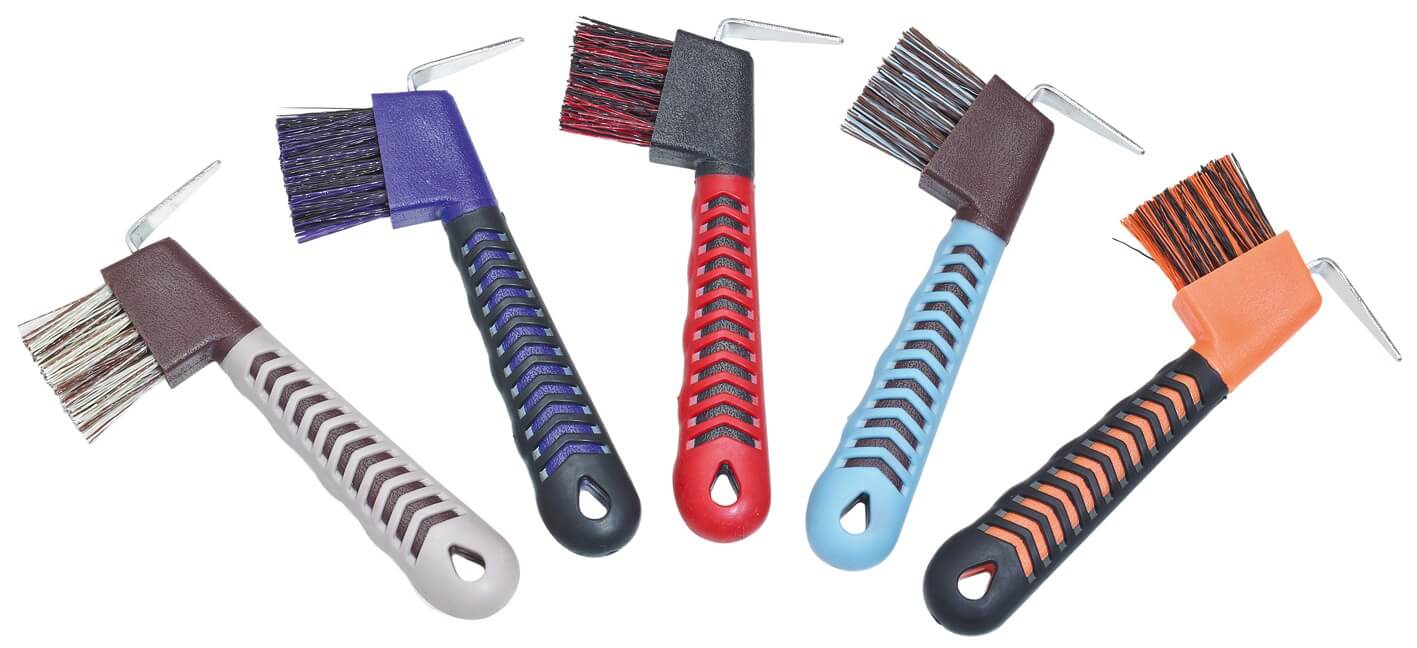

 Po lewej: kopyto z postępującym procesem gnilnym. Po prawej: zdrowe rozczyszczone kopyto, źródło: heikebean.com
Po lewej: kopyto z postępującym procesem gnilnym. Po prawej: zdrowe rozczyszczone kopyto, źródło: heikebean.com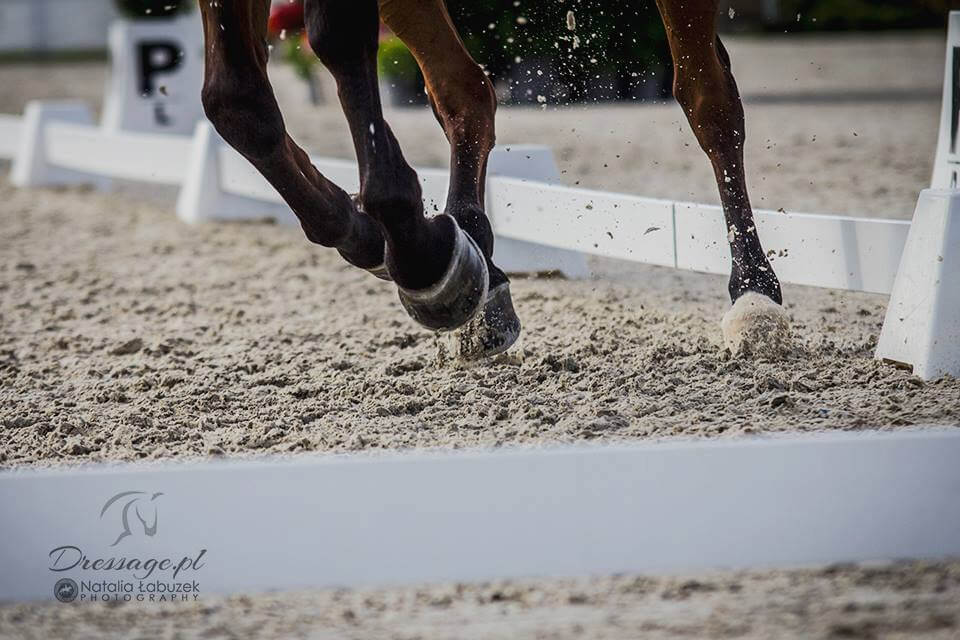 źródło:
źródło:  Miejsce mierzenia tętna - pęcina, źródło tła: theequinest.com
Miejsce mierzenia tętna - pęcina, źródło tła: theequinest.com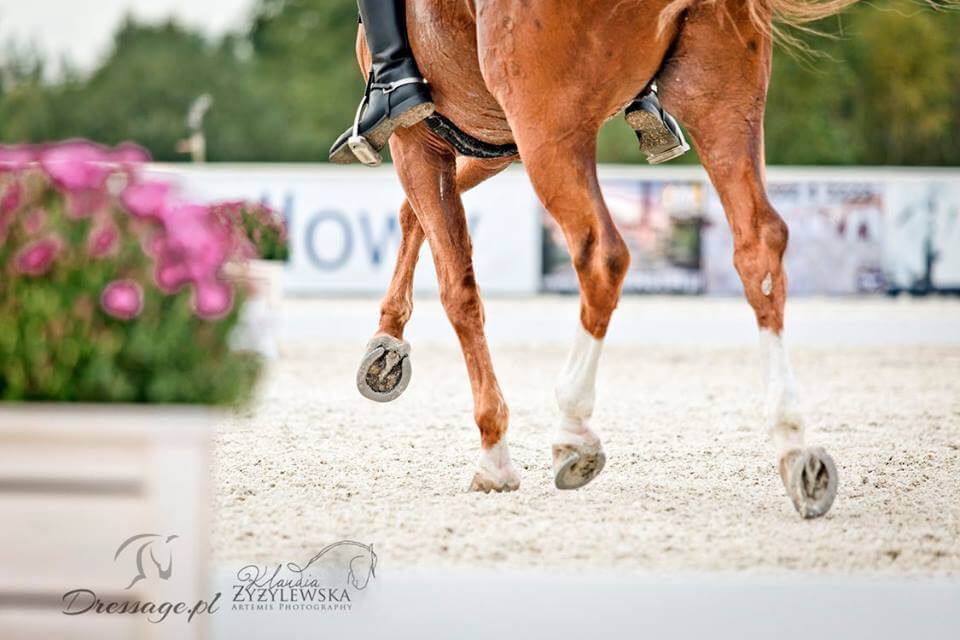 źródło:
źródło:  źródło:
źródło: 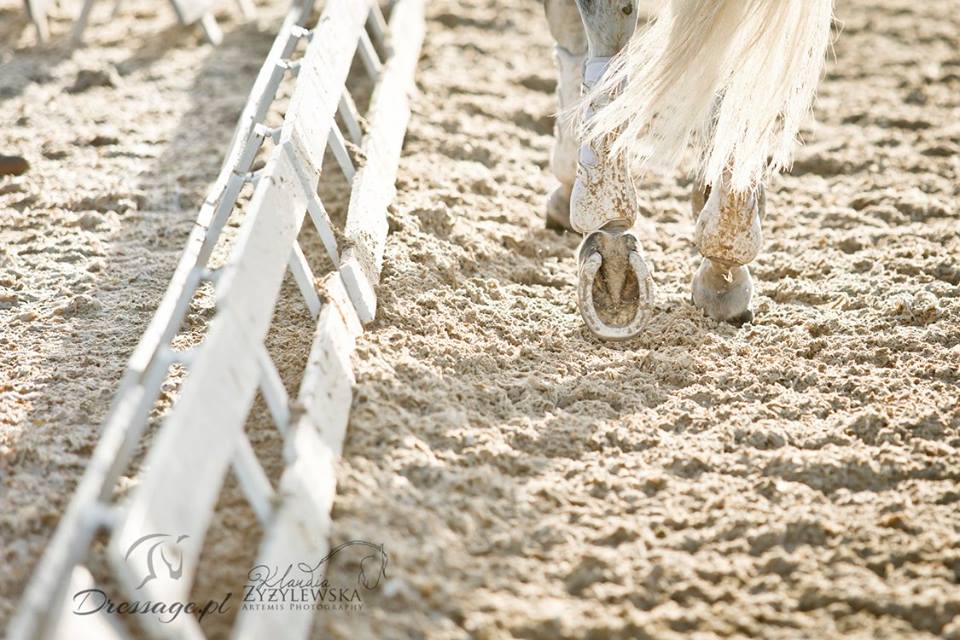 źródło:
źródło: 